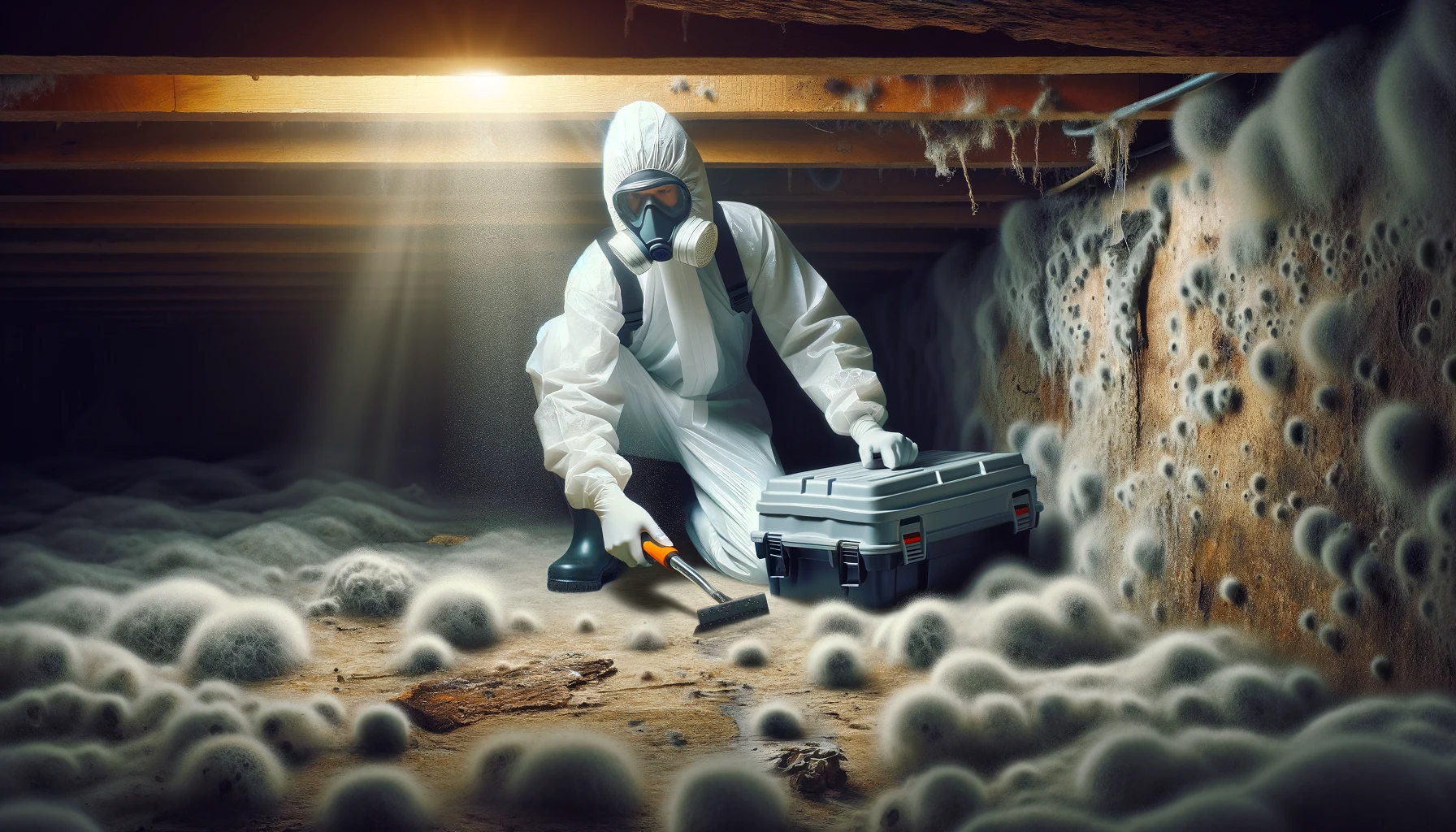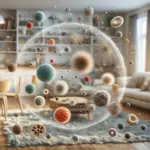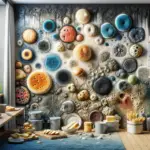Crawlspace mold removal is something you should take seriously. Mold can cause a lot of damage to your home and have serious health effects, so it’s important to get rid of it as soon as possible.
Navigating the crawl space isn’t an experience many of us look forward to, but since your entire house is stinking up with a musty scent and you’ve looked everywhere else in vain, it’s time to take matters into your own hands.
To get rid of mold from crawl spaces, hiring a professional remediation company that can safely remove the fungus is best. They’ll be able to identify the source of the mold, assess the damage, and provide the proper treatment to get rid of it completely. However, there are some steps you can take on your own for minor cases. So if you think your crawlspace might have a mold problem, don’t hesitate—get it taken care of before it gets out of control!
What Is Mold?
Mold is a type of fungus that grows in damp and humid environments, particularly in places where organic materials are abundant – such as wood, paper, or food – for it to feed on. Mold can vary greatly in species and appearance; some varieties are visible to the naked eye while others may require microscopic examination. The most common kinds of mold are Alternaria, Cladosporium, Penicillium, and Aspergillus.
Alternaria
This type of mold is the most common indoor air pollutant. It has a fuzzy, black appearance and is often found in window frames and bathrooms.
Cladosporium
This kind of mold looks like dark green spots or smears on wood, paper, or fabric and can trigger asthma attacks in some people.
Penicillium
This type of mold is usually blue-green and can be found in food, wallpaper, or textiles.
Aspergillus
This variety of mold looks like a white or gray powdery substance on surfaces and can cause respiratory problems if inhaled.
Despite being the most typical varieties, any species of mold can cause serious health risks if left untreated or exposed for extended periods.
What Are Mold Spores?
Mold spores are microscopic airborne particles that can travel long distances and can settle on virtually any surface. Mold reproduces through the release of these tiny reproductive cells, which can become a problem when they enter your home or business. Mold spores are particularly dangerous because they are hard to detect until significant damage has been done.
How Does Mold Grow?
Mold begins to grow when the conditions are right – warm temperatures, high humidity, and a food source. If any one of these factors is missing, mold will not form. Mold can take hold in as little as 24-48 hours after it has been exposed to these favorable conditions.
Once mold spores develop, they can spread quickly through the air and find other spots in your home to grow. When mold is present in a crawlspace, it can spread through the house and potentially cause health problems for anyone living inside. Consequently, it is essential to stay vigilant for symptoms of mold and promptly act if any are seen before the problem spreads.
What causes Mold in Crawl Spaces?
Mold in your crawl space is typically caused by moisture. Excess water can enter the area through a leaky pipe, foundation cracks, or other entry points. Other factors that can contribute to mold growth include poor ventilation and inadequate drainage systems. Allowing moisture to remain in your crawl space can create the perfect environment for mold to thrive.
Why is Mold Growth Common in Crawl Spaces?
Due to its location, the crawl space is a prime spot for mold growth. Right below your home and on top of the earth, high moisture and humidity levels can create an environment where mold thrives. There is often a lack of fresh air reaching the floor joists, along with many tight spaces.
Even if you have plastic vapor barrier installed in the area, it may not be enough to prevent problems from occurring as soil and dirt contain moisture which fulfills one requirement for mold formation – alongside wood that acts as food source. With such limited air circulation within this enclosed region providing ample dampness, it’s easy to understand why dirt crawl spaces are prone to becoming breeding grounds for undesirable fungi.
What Are The Signs Of Mold In Your Crawl Space?
Leakes and Flooding
Crawl spaces are at risk of flooding during periods of intense rain. If your crawl space floods, mold could appear immediately after the water recedes.
If you have cracks in your basement floor or walls, you should also investigate if they are linked to any moisture penetration that may exacerbate your mold problem. For example, faulty sump pumps, poor grading around your foundation, and improperly sealed windows could be the source of the problem.
Some crawl space designs call for plastic sheeting on the floor; this barrier traps water against the foundation walls. The trouble is that the plastic breaks down over time. As it deteriorates, holes develop, and water seeps through them into the soil. Water accumulates in the crawl space just as it does in any basement.
Condensation and Humidity
Mold spores can quickly take hold in a moist crawl space, so it’s important to keep the humidity levels below 50%. A humid crawl space creates the perfect scenario for mold to grow. To counter this problem and prevent your home from becoming susceptible to fungi, you should use fans or dehumidifiers to reduce the relative humidity.
HVAC Systems (Heating, ventilation, and air conditioning ) problems
Mold in the crawl space can spread into the HVAC system. It may travel up through the home’s air ducts, filling the house with an odor and depositing spores in new areas for growth.
Buckled hardwood floors
Wooden flooring can quickly become warped and disfigured with mold, leading to an undesirable and unsightly presence in your home.
Wall staining and discoloration
Mold can cause wallpaper and drywall to discolor and become stained from water damage. This is especially common when the crawl space has been flooded or had a history of high moisture levels.
Musty smells
One of the most common signs of mold is a musty odor. When it reaches high levels, you’ll start to smell something off in your home, even if the naked eye can’t see it. Crawl space mold can cause musty odors in your home, affecting indoor air quality.
Visible mold growth
This is the most obvious sign of mold, but you should never wait for it to become visible before addressing the issue. Mold grows and spreads quickly in an enclosed space and causes health problems, so if you suspect there might be a problem with mold, it’s best to act immediately.
Health Issues
Allergic reactions and difficulty breathing, skin rashes, headaches, and sneezing; are all symptoms of mold exposure. The long-term effects of mold inhalation can be very serious, so you should take any signs of mold seriously and address them as soon as possible.
Crawl Space Mold Removal – How To Do It?
Eradicating crawl space mold from your residence can be a tricky process, but there are some measures you can take to remove it successfully.
- To protect yourself, be sure you have the proper personal protective equipment (PPE) on hand such as gloves, a face mask and appropriate clothing.
- Set up lights, and lay down plastic sheets to catch mold as it’s cleaned from surfaces. If the job seems too big, contact a mold remediation company right away.
- To get rid of mold in your crawl space, you’ll need to eliminate the source of the mold first. This means dealing with any leaking water sources or ventilation issues.
- Clean up any mold with a specially formulated foaming spray. Give the cleaning product some time to expand throughout affected areas and loosen the mold, at which point you can start scrubbing away. Keep in mind that this is a delicate process; use caution as you clean up!
- Soak the area with special mold removal cleaners. To eliminate any last traces of mold, use either homemade (vinegar, hydrogen peroxide, baking soda and borax) or commercial molds-killing solutions. Commercial products are more successful and may even help remove the stains caused by mold.
- Dry the area thoroughly with a wet-dry vacuum, and use fans to increase air circulation in the crawl space. Finally, install an effective dehumidifier system to maintain a lower level of moisture in your home. This will help to prevent mold from growing again in the future.
- Be sure to properly discard all items. Meticulously fold up your plastic sheeting and place it inside a robust trash bag. Dispose of coveralls, brushes or any other contaminated equipment the same way. Leave the sealed items outside until garbage collection day for ultimate protection and safety purposes.
Remember to remain vigilant and take immediate action when it comes to moisture levels in your home; this is key to preventing a reoccurrence of mold growth. With some care and effort, your home will be free of mold, and you can enjoy a healthier and more pleasant environment.
Crawl Space Mold Remediation
If you suspect your crawl space is infected with mold, it’s best to call a mold remediation specialist. A certified technician can inspect the area and remove any existing mold growth. If the problem is severe, they may suggest replacing portions of the floor or walls to prevent further damage. In some cases, treatments such as chemical sprays may be used to eliminate the mold.
Crawl space mold removal is a very challenging process. With the necessary protective clothing and tight spaces, it’s tough to kill mold in a crawl space. This mold remediation in the crawl space and the associated mold cleanup is not usually a DIY project.



